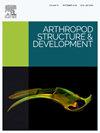The role of hydraulic pressure in spider cheliceral function
IF 1.3
3区 农林科学
Q2 ENTOMOLOGY
引用次数: 0
Abstract
Recent μCT-based surveys of spider chelicerae highlight a problematic aspect of skeletomuscular function, that is, the absence of extrinsic muscles capable of projecting the chelicerae outward or forward. Instead, all appear to generate an inward or rearward force. Previous work by comparative anatomists assigned antagonistic functions to sets of extrinsic muscles, but no anatomically distinct pivot points within a lever-based system were specified and do not appear to exist. These observations led us to revisit the problem and to propose a significant role for internal hydraulic pressure in cheliceral movement. The hydraulic hypothesis predicts that unimpeded increase in internal fluid pressure should result in inflation of basal membranes resulting in movement that could be resisted and manipulated by extrinsic cheliceral muscles. Experiments on freshly killed spiders showed that increased hydraulic pressure causes both rotational (adduction, levation, etc.) and translational (projection) movements at the cheliceral bases, movements that are synergistic with predatory strikes. This suggests that the co-option of hydraulics into cheliceral function may have increased cheliceral biting forces. Hydraulic function also allows for the basal cheliceral articulation to simultaneously produce both rotational and translational movement, a challenge for a lever-based fixed articulation. The co-option of hydraulics into additional tasks may have contributed to the evolutionary success of spiders, compared to their arachnid relatives that use hydraulics solely for locomotion.
水压在蜘蛛化学功能中的作用
最近对蜘蛛螯肢的μ ct调查强调了骨骼肌功能的一个问题,即缺乏能够向外或向前投射螯肢的外部肌肉。相反,所有这些似乎都产生一种向内或向后的力量。比较解剖学家先前的工作将拮抗功能分配给外部肌肉组,但在基于杠杆的系统中没有指定解剖学上不同的枢轴点,似乎不存在。这些观察结果使我们重新审视这个问题,并提出内部液压在化学运动中的重要作用。水力假说预测,内部流体压力的无阻碍的增加会导致基底膜的膨胀,从而导致运动,这种运动可能被外部的化学肌肉所抵制和操纵。对刚被杀死的蜘蛛进行的实验表明,液压压力的增加会导致化学碱基的旋转(内收、上升等)和平动(投影)运动,这些运动与掠食性攻击协同作用。这表明,将液压系统加入到化学功能中可能会增加化学咬合力。液压功能还允许基础化学关节同时产生旋转和平移运动,这对基于杠杆的固定关节是一个挑战。与蜘蛛的蛛形纲亲戚只使用液压系统进行运动相比,蜘蛛在进化上的成功可能得益于液压系统的附加任务。
本文章由计算机程序翻译,如有差异,请以英文原文为准。
求助全文
约1分钟内获得全文
求助全文
来源期刊
CiteScore
3.50
自引率
10.00%
发文量
54
审稿时长
60 days
期刊介绍:
Arthropod Structure & Development is a Journal of Arthropod Structural Biology, Development, and Functional Morphology; it considers manuscripts that deal with micro- and neuroanatomy, development, biomechanics, organogenesis in particular under comparative and evolutionary aspects but not merely taxonomic papers. The aim of the journal is to publish papers in the areas of functional and comparative anatomy and development, with an emphasis on the role of cellular organization in organ function. The journal will also publish papers on organogenisis, embryonic and postembryonic development, and organ or tissue regeneration and repair. Manuscripts dealing with comparative and evolutionary aspects of microanatomy and development are encouraged.

 求助内容:
求助内容: 应助结果提醒方式:
应助结果提醒方式:


